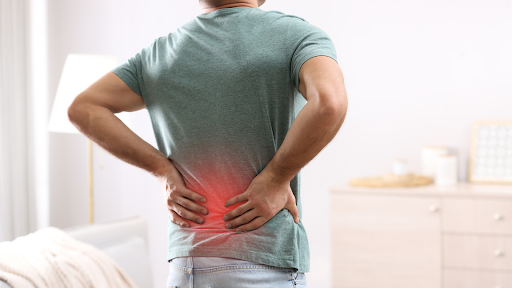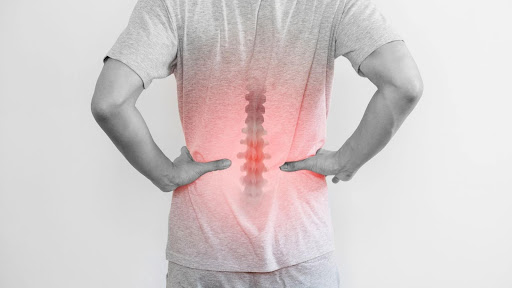Complete Guide to Back Pain: Causes, Prevention, and Advanced Non-Surgical Treatments Explained
 Back pain is one of the most common health problems almost everyone experiences at some point. For some, it’s a dull ache after a long day and for others, it’s severe enough to disturb sleep, work and daily life. Knowing why back pain happens, how to prevent it and the treatment options available can make it easier to manage and improve your overall quality of life.
Back pain is one of the most common health problems almost everyone experiences at some point. For some, it’s a dull ache after a long day and for others, it’s severe enough to disturb sleep, work and daily life. Knowing why back pain happens, how to prevent it and the treatment options available can make it easier to manage and improve your overall quality of life.This guide breaks down the causes, prevention tips, and the latest treatments in plain, easy-to-understand language. It also highlights how advanced care from experts like Dr. Ekta Gupta, available through DocGenie, can help people find effective relief without the need for surgery.
What Causes Back Pain?
 Your back is a strong structure made of bones, discs, joints, muscles and nerves. Pain can come from any of these and can be caused by injuries, lifestyle habits, medical conditions or a combination of these factors. Here are the most common reasons:
Your back is a strong structure made of bones, discs, joints, muscles and nerves. Pain can come from any of these and can be caused by injuries, lifestyle habits, medical conditions or a combination of these factors. Here are the most common reasons:- Muscle Strain - Sudden movements, lifting something heavy the wrong way or repeating the same action again and again can strain the muscles and ligaments in your back. This strain can cause small tears, leading to pain and stiffness.
- Poor Posture & Sitting Too Long - Spending lots of time sitting, especially with a curved or slouched back, puts extra strain on the spinal discs and muscles. People who spend a lot of time at computers or driving often develop this type of pain, usually in the upper or lower back.
- Slipped Disc - The soft cushion between your spine bones can bulge and press on a nerve, causing sharp pain or sciatica (pain running down the leg).
- Age & Wear-and-Tear -As we get older, our spinal discs lose water and flexibility, making the spine less cushioned and more prone to pain. This natural wear and tear is called degenerative disc disease
- Injuries and Trauma - Falls, accidents or sudden impacts from sports or daily activities can injure the back, causing fractures, sprains or even nerve damage. If not treated quickly and properly, these injuries may lead to long-term pain
- Other Health Issues - Sometimes, back pain can be a symptom of medical issues like kidney infections, gallbladder problems, or spinal infections. Conditions such as scoliosis (curved spine) or osteoporosis (weak bones) also increase back pain risk.
- Gender-Specific Causes - In women, pregnancy can strain the lower back because of extra weight and changes in posture. Hormonal shifts during periods or menopause may also affect ligament flexibility and pain sensitivity. In men back pain is often linked to heavy lifting, sports injuries, or physically demanding work. Still, many causes are common to both men and women, with lifestyle playing a major role.
Types of Back Pain
Back pain generally falls into four main types:- Acute Back Pain - A sudden pain that lasts less than 6 weeks, usually after an injury or strain and often gets better with rest and care.
- Chronic Back Pain - Pain that lasts for 3 months or more. It may be due to ongoing issues like arthritis or degenerative disc disease.
- Neuropathic Pain - Caused by nerve damage or pressure on nerves. Sciatica is a common example where pain shoots down the leg because of a pinched nerve.
- Referred Pain - Pain felt in the back but caused by another organ, such as kidneys, stomach or reproductive system.
Causes of Upper Back Pain
Upper back pain is less common than lower back pain, but still affects many people. The upper back is supported by strong muscles around the ribs and spine, but pain here can often occur due to:- Poor posture, like slouching while using a phone, computer, or driving
- Muscle strain from lifting or repeating the same movements
- Injuries or accidents, such as whiplash from car crashes
- Arthritis affecting the spine joints
- Stress and tension, which can make the muscles tight and sore
How to Prevent Back Pain?
 Prevention is always better than cure. Making simple lifestyle changes can protect your back and reduce the risk or severity of pain.
Prevention is always better than cure. Making simple lifestyle changes can protect your back and reduce the risk or severity of pain.- Stay Active and Exercise Regularly - Physical activity helps keep your back muscles strong and spine flexible. Low-impact exercises like walking, swimming, yoga, or cycling are excellent choices. Strengthening the core muscles (abdomen and lower back) is very important because they support your entire spine.
- Practice Good Posture - Whether sitting, standing, or walking, maintaining a neutral spine position reduces pressure on your back. Keep your shoulders back, avoid slumping, and make sure your work desk and chair are ergonomically designed.
- Use Proper Lifting Techniques - When lifting heavy objects, bend your knees, keep the load close to your body, and avoid twisting your spine. Use your leg muscles to do the lifting rather than your back.
- Avoid Long Periods of Sitting or Standing - Don’t sit or stand for too long, move every 30 minutes.
- Maintain a Healthy Weight and Balanced Diet - Excess weight puts strain on your back. A balanced diet with calcium, vitamin D and plenty of fluids helps keep your bones and muscles strong and healthy.
- Quit Smoking and Manage Stress - Smoking reduces blood flow to spinal tissues, which slows healing. Stress tightens the muscles and makes pain feel worse, so practicing relaxation and mindfulness can be very helpful.
Learn More: Symptoms of Sciatica Pain: How to Recognize and Manage
Back Pain Medicines and Treatments
Most cases get better without surgery. Here are the options doctors recommend:- Medicines - For mild to moderate pain, over-the-counter medicines like paracetamol and ibuprofen are effective. In some cases, doctors may prescribe stronger painkillers, muscle relaxants, or medicines targeting nerve pain. It is important never to self-medicate with drugs and follow your doctor’s advice
- Physical Therapy - A physical therapist designs personalized exercises to improve strength, flexibility and posture. This therapy also teaches pain relief techniques and safe movement habits.
- Pain Relief Injections - When nerve pain is involved, targeted injections like epidural steroid shots or nerve blocks can provide significant relief without surgery.
- Regenerative Medicine - New therapies, such as Platelet-Rich Plasma (PRP) injections, use your body’s healing factors to repair damaged tissues, reducing pain and improving function.
- Hot and Cold Therapy - Applying heat relaxes muscles and improves blood flow, while cold reduces inflammation and numbs sharp pain.
- Alternative Treatments - Acupuncture, chiropractic care, and massage therapy can complement conventional treatments for some individuals.
- Surgery - Surgery is rarely needed and is considered only when conservative treatments fail, or serious nerve damage occurs.
How to Relieve Severe Lower Back Pain at Home
If you experience severe lower back pain, here are immediate steps to relieve discomfort:- Use a cold pack during the first 48 hours to reduce swelling, then switch to heat therapy.
- Avoid bed rest for more than 1-2 days, gentle movement helps you recover faster.
- Try light stretches after the worst pain eases
- Take prescribed pain medications only as directed.
- Seek medical advice quickly if pain worsens or neurological symptoms like numbness occur.
When Should You See a Doctor?
Consult a doctor if:- Pain persists over 4-6 weeks despite home care.
- You experience numbness, tingling, or weakness in legs.
- You have loss of bladder or bowel control.
- Pain follows a serious injury or accident.
- Pain worsens or limits daily function severely.
Expert Pain Care by Dr. Ekta Gupta at DocGenie
Dr. Ekta Gupta is a highly experienced pain specialist with over 16 years of expertise in advanced, non-surgical treatments to help patients recover from back pain. Through DocGenie, a convenient telemedicine platform, people across India can access her guidance and care right from their homes.Back pain is common, but you don’t have to live with it. By understanding the causes, taking simple preventive steps and knowing when to seek expert help, you can get back to living pain-free.
Take the first step towards a healthier back today!



